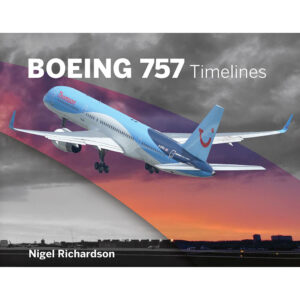The Boeing 757 is a single aisle, short-medium range aircraft, with two under-wing engines.
It was developed as a successor to the Boeing 727, with the prototype completing its maiden flight on the 19 February 1982. After a 1,380 hour flight test programme, including the pre-requisite testing for certification, the first production 757-200 was delivered to Eastern Air Lines on the 22 December 1982, followed by an inaugural revenue service on the 1 January 1983.
The 757 was developed in parallel with the Boeing 767, and shared many parts and systems including the same engines, the use of improved aluminium alloys and graphite composites in the structure, and fully-computerised avionics and instrumentation resulting in almost identical glass cockpits.
The airliner is powered by Rolls-Royce RB211 or Pratt & Whitney PW2000 turbofan engines. The unusually high thrust-to-weight ratio of the aircraft meant it was capable of operating out of airports with short runways or those affected by hot or cold weather, and led to it becoming known as the ‘pocket rocket’.
Boeing went on to develop a number of different variants of the Boeing 757, which we’ll describe here:
Boeing 757-200

Boeing 757-236 G-LSAD of Jet2.com until March 2020. (Nigel Richardson)
The initial production variant was the passenger carrying 757-200. It is 155ft 3in long (47.32m), with a height of 44ft 6in (13.56m), a width of 12ft 4in (3.76m) and a wingspan of 124ft 10in (38.05m).
The fuselage width is the same as the Boeing 707, 727 and 737. The interior cabin has a length of 118ft 4in (36.09m) and width of 11ft 7in (3.53m) and can accommodate 200-239 passengers depending on the seating configuration. The earlier 757-200s were powered by two Rolls-Royce RB211-535C engines with the Rolls-Royce RB211-535E4, RB211-535E4B, Pratt & Whitney PW2037 and PW2040 subsequently added as options. In 1986, Rolls-Royce RB211 powered 757s were approved for 120 minutes extended-range twin-engine operational performance standards (ETOPS) operations, followed by the Pratt & Whitney PW2000 powered 757s in 1990.
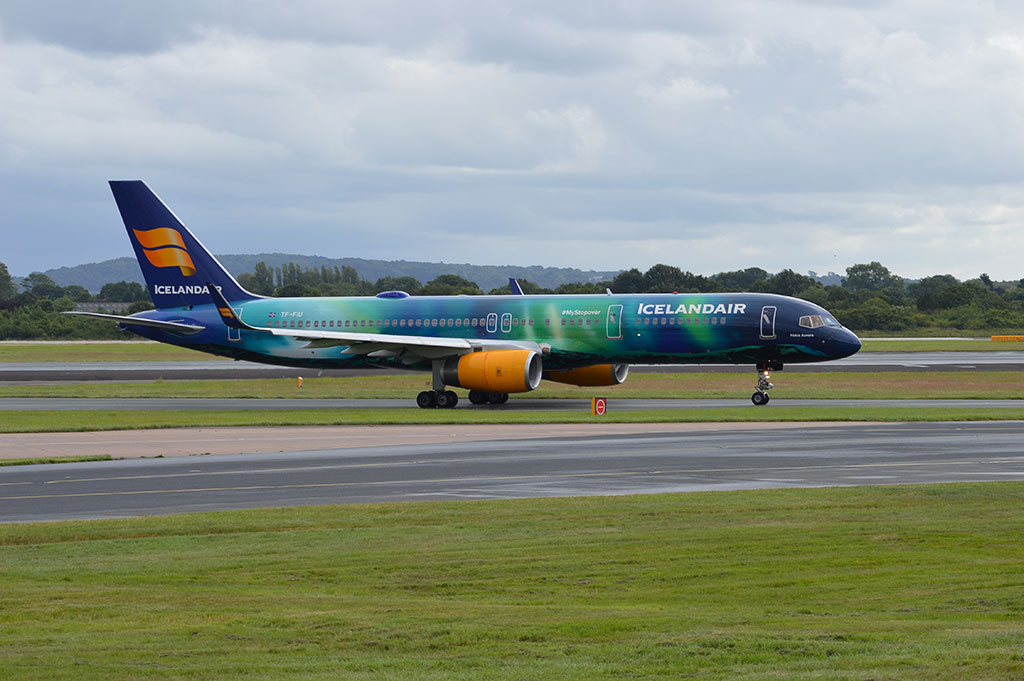
Boeing 757-256 TF-FIU of Icelandair, painted in special Northern Lights colour scheme. (Nigel Richardson)
With a maximum range of almost 4,000nm, this opened up transatlantic route options to the 757 and US and European scheduled airlines began to take up these improved opportunities from May 1990.
In addition to the initial prototype, 913 757-200s were built. The final 757-200, and the last 757 to be built, rolled off the production line at Renton on 28 October 2004 and was delivered to Shanghai Airlines on 28 November 2005, after several months of storage.
Boeing 757-300
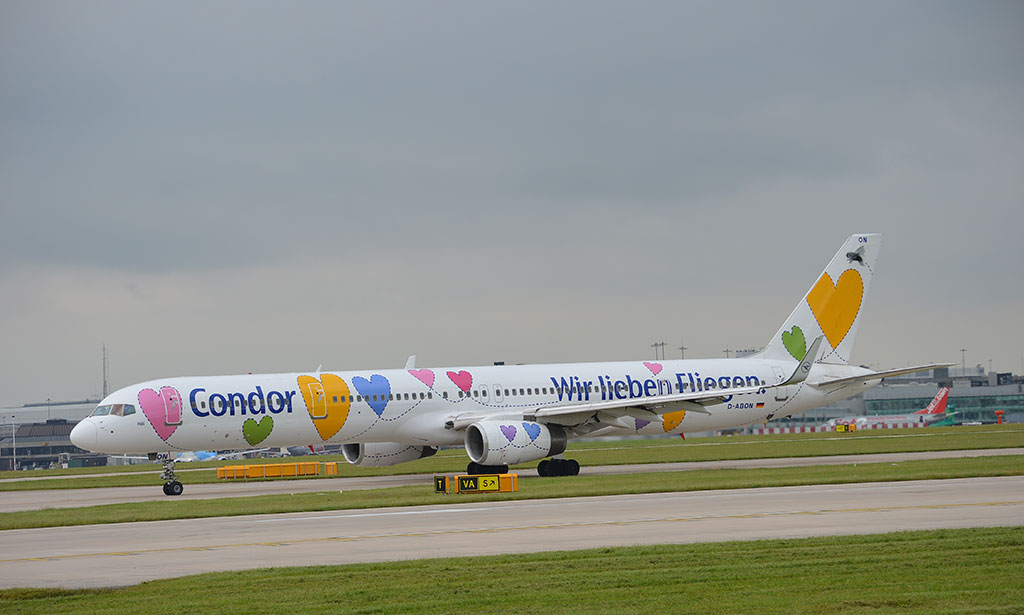
Boeing 757-330 D-ABON of Condor, the first carrier to take delivery of 757-300s (Nigel Richardson)
The 757-300 was developed to mainly serve the charter airline market. It was launched in 1996 and began services with Condor in March 1999.
The longer, stretched 757-300 includes an extension of the front fuselage section by 13ft 4in (4.06m) and a 10ft (3.05m) extension of the rear fuselage section. This provides accommodation for between 243 and 289 passengers depending on the seating configuration.
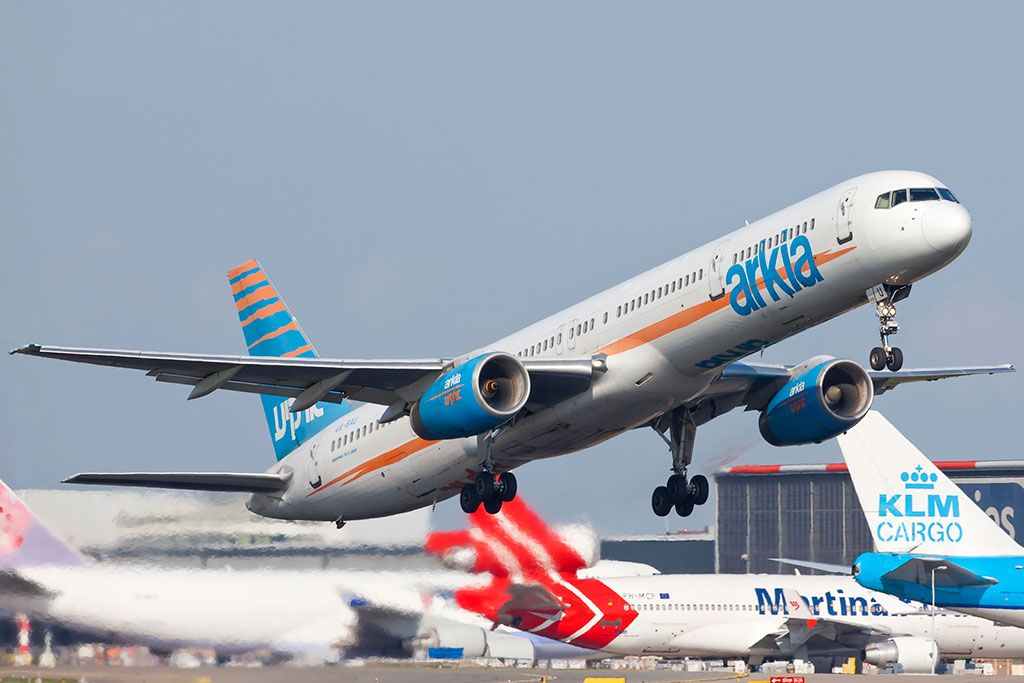
Boeing 757-300; 4X-BAU of Arkia Airlines (Maarten Visser, licensed under CC BY-SA 2.0)
It retains the basic design of the original 757-200, including the same wings, although it is structurally reinforced to accommodate the increased weight and additional load of the extended fuselage, with strengthening of the wings, central fuselage section, horizontal stabiliser and undercarriage.
A retractable tail-skid is fitted to prevent possible damage to the rear fuselage as a result of tail strikes during take-off and landing. The aircraft is powered by two Rolls-Royce RB211-535E4B or Pratt & Whitney PW2043 engines. The 757-300 has a maximum range of 3,400nm. Boeing built fifty-five 757-300s, with the final aircraft delivered to Continental Airlines in April 2004.
Boeing 757-200PF
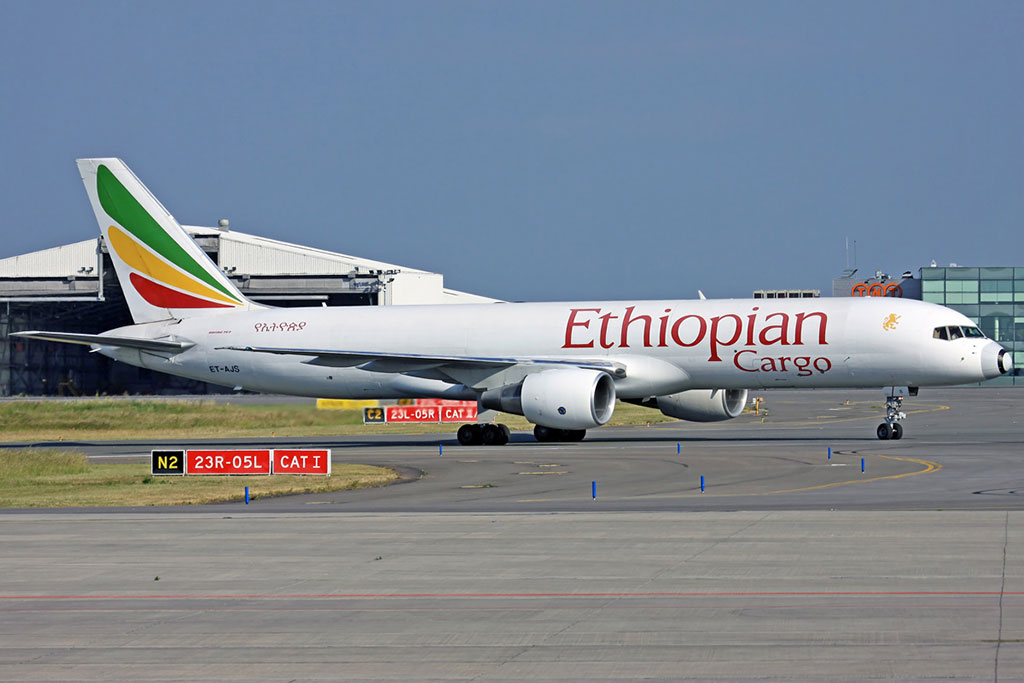
Boeing 757-260PF ET-AJS of Ethiopian Airlines Cargo. (Eduard Heisterkamp)
The 757-200PF (Package Freighter) was announced by Boeing on 30 December 1985 following an order for twenty freighter versions, plus fifteen options from UPS. The 757-200PF differs from the 757-200 passenger version in that it has no cabin doors, windows or interior passenger amenities.

The main cargo compartment of a Boeing 757-260PF of Ethiopian Airlines Cargo. (Raimund Stehmann)
Access to the cockpit is through a small crew entry door or ‘hatch’ on the port side of the aircraft near the cockpit window, in place of the normal forward loading door. A large, upward opening main-deck cargo door is also installed on the port side of the forward fuselage, between the leading edge of the wing and the flight crew compartment, for bulk loading and unloading of standard cargo containers or pallets.
The main deck fuselage interior is lined with a smooth fibreglass finish and optimised for the transport of freight. There is a solid bulkhead with a sliding door at the front end of the main deck which acts as a restraint wall between the flight deck and the main cargo deck. The maximum revenue payload capability is 87,700lb (39,780kg) including the container weight.
The volume of the main deck is 6,610 ft3 (187m3), capable of accommodating up to 15 standard-size ULD containers or pallets. It is supplemented by two lower deck holds – one forward of the wings, one behind the wings – which provide an additional 1,830 ft3 (51.8m3) of space for bulk cargo. The aircraft is powered by either Pratt & Whitney PW2037 or PW2040 turbofans, or Rolls-Royce RB.211-535E4B engines.

Boeing 757-24APF N446UP of UPS (Dylan Ashe/Altair78, licensed under CC BY-SA 2.0)
The first 757-200 PF was rolled out at Boeing’s Renton site on 15 July 1987. UPS received its first two aircraft on 16-17 September 1987. A total of eighty 757-200PFs were built at Renton with operators including UPS, Ansett Worldwide, Asia Pacific Airlines, Swiftair and DHL Austria.
Boeing 757-200M
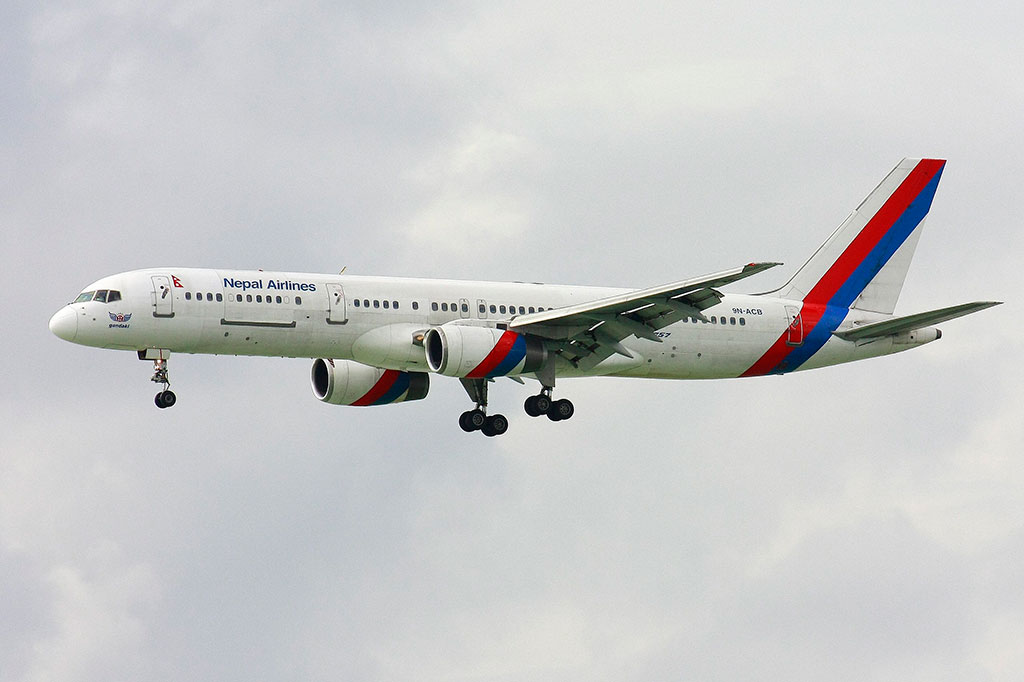
Only one 757-200M Convertible or ‘Combi’ freighter was built and delivered to Royal Nepal Airlines in September 1988, registered 9N-ACB. (Toby Lam, licensed under CC BY-SA 2.0)
The Boeing 757-200M (sometimes referred to as the 757-200C) is a convertible or ‘combi’ freighter which is capable of carrying a combination of freight and passengers on the fuselage main deck in a mixed configuration.
A main cargo door, similar to that installed on the 757-200PF, is fitted on the port side of the fuselage, forward of the wing. All windows, cabin doors and the cabin interior are retained from the passenger 757-200.
The initial variant could carry 2-4 freight pallets or cargo containers and between 123 and 148 passengers, or be relatively quickly converted to carry a full passenger load. In the mixed mode, the cargo was carried in the forward section of the main deck, separated from the passengers by a moveable partition.
There was very little interest in the 757-200M from freight operators and only one aircraft was built for Royal Nepal Airlines (Nepal Airlines since 2007). The aircraft made its first flight on 15 July 1988 and entered into service in September of the same year.
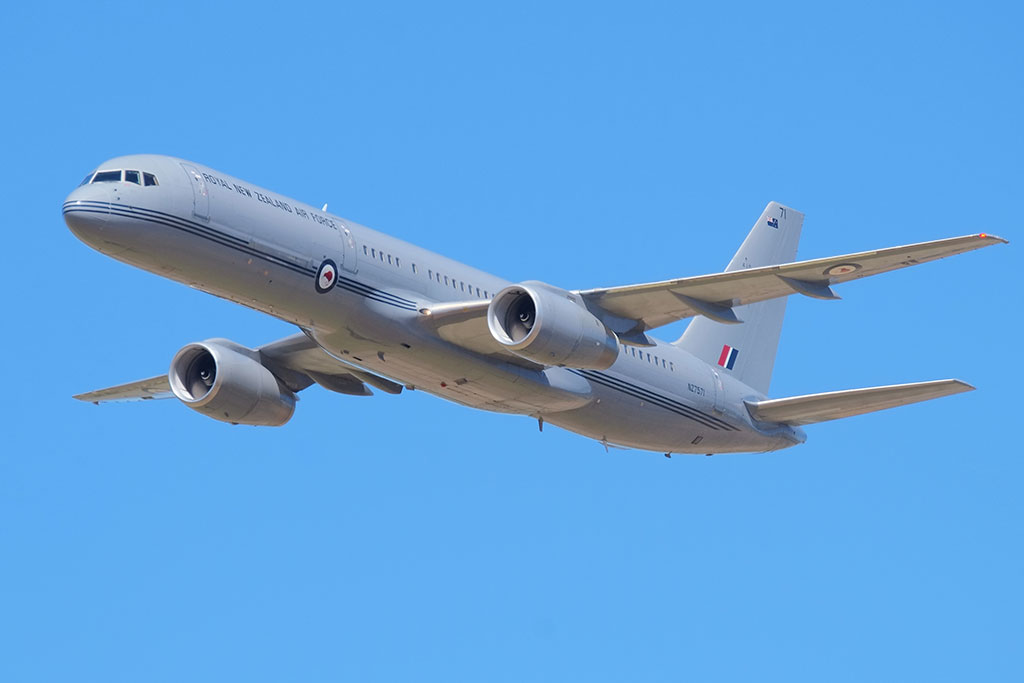
Royal New Zealand Air Force Boeing 757-2K2 NZ7571. One of the two former passenger 757-200s converted to 757-200 combi freighters for the Royal New Zealand Air Force (Pseudopanax)
In 2007/2008, Singapore Technologies Aerospace (ST Aerospace), via VT Mobile Aerospace Engineering, completed the conversion of two former passenger 757-200s into 757-200 combi freighters for the Royal New Zealand Air Force to be used in a flexible, multi-purpose role. The two 757s had previously operated for ten years for charter carrier Transavia Airlines.
The conversion work included the installation of a main deck cargo door, fitting a strengthened floor for the carriage of large and heavy cargo (with a capability to carry eleven cargo pallets) together with a cargo handling system. In-built air stairs on one of the rear passenger doors and a flight crew boarding ladder in the nose wheel bay allowed for operations from remote airfields without any infrastructure.
ST Aerospace also completed a passenger aircraft to passenger/cargo combi conversion on a former Air Finland 757-200 in 2011 for use by TNT Airways. The combi configuration provided capacity for eight containers in the forward section of the main deck and up to eighty passengers in the rear cabin section.

Precision Aircraft Solutions’ first Precision Conversion Combi (757-2Q8PCC) which entered into service with Air Transport International in June 2013. (Precision Aircraft Solutions)
Similar conversions have been undertaken by Pemco World Air Services and Precision Aircraft Solutions. The Precision Conversion Combi (PCC) features a cargo compartment with up to ten full cargo positions (over 50,000lb cargo capacity), a main cargo door, a rigid barrier between the cargo compartment and the passenger compartment (with seating for up to 54 passengers), and a small crew entry door on the port side immediately behind the cockpit window, similar to the 757-200PF. It is also the only 757-200 combi to include winglets. The company’s first conversion, a former Aeromexico and SunExpress 757-200, entered into service with Air Transport International in June 2013.
Boeing 757-200 SF/PCF
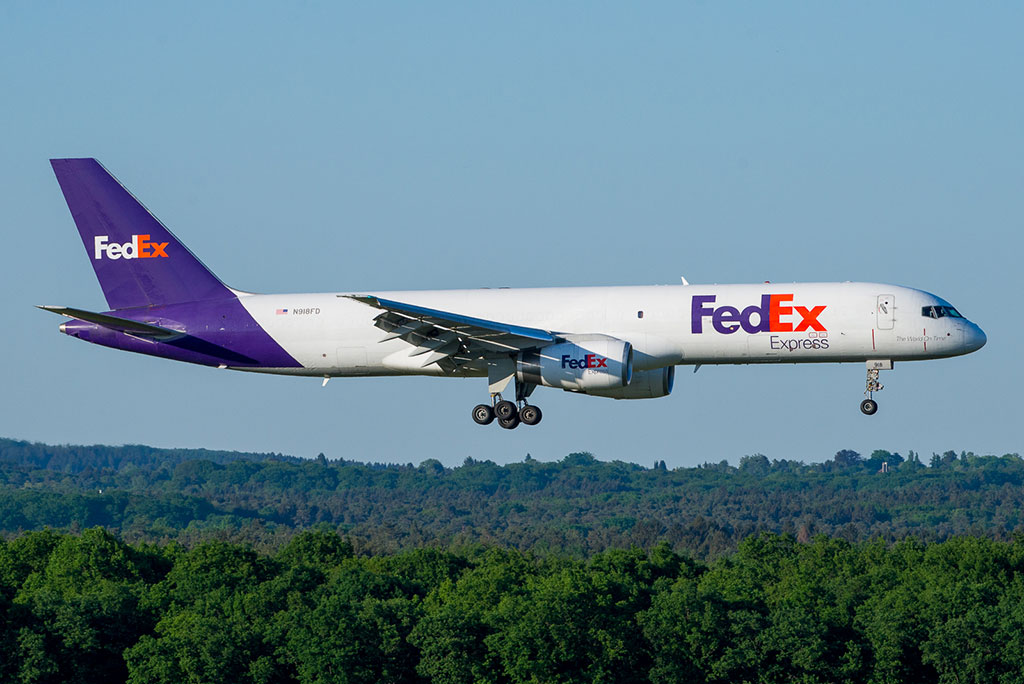
Boeing 757-23ASF N918FD of FedEx Express converted from a passenger-carrying 757 by Alcoa-SIE Cargo Conversions using a P2F conversion design called the 14Plus 757-200 conversion. (BriYYZ, licensed under CC BY-SA 2.0)
The third 757 freighter variant involves the direct conversion of a passenger 757-200 into a pure freighter, a so-called P2F conversion.
P2F conversions have been carried out by a range of companies, including Boeing. All conversions involve the installation of a main cargo door on the left-hand side forward fuselage, identical to that used on the 757-200PF aircraft. In addition, most conversions involve the sealing of all cabin doors (except the two forward boarding and galley doors), the plugging of the cabin windows, removal of cabin passenger furnishings and amenities (e.g. galleys, seats, toilets, over-head lockers), the structural reinforcement of sections of the main deck floor and the fitting of a cargo handling systems, such as roller tracks. The 757 main cargo deck has the capacity for fourteen standard pallets and one smaller container.
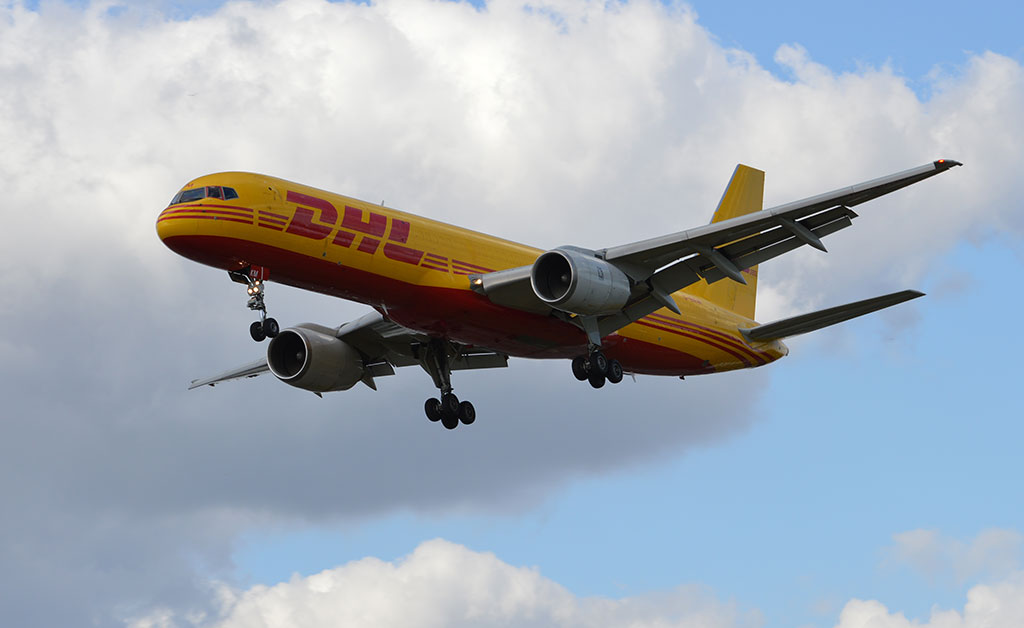
Boeing 757-236SF G-BHKM of DHL Air (Nigel Richardson)
Boeing Airplane Services completed the first conversions at its Wichita site involving thirty-four 757-200s purchased from British Airways in 1999. The converted aircraft were supplied to DHL International and their subsidiary, European Air Transport Leipzig (EAT). The new P2F freighter was designated the 757-200SF (Special Freighter) and the first converted aircraft made its maiden flight on 15 February 2001 before delivery to DHL Aviation (UK) on 10 January 2002 and entry into service later the same month. Up to 60,000lb of freight could be carried by the freighter.
In 2007, ST Aerospace and subsidiary VT Mobile Aerospace Engineering began an eight year conversion programme of 119 passenger 757-200s to 757-200SF freighters for FedEx. The first aircraft was introduced into its fleet in July 2008 and all aircraft had been delivered by mid-2015.
Alcoa-SIE Cargo Conversions developed a second P2F conversion design in 2005 called the 14Plus 757-200 conversion, which resulted in a 757-200ASF configuration. It involves a less complex conversion and retains most of the 757-200s original structure and systems, resulting in a quicker conversion at lower cost. It features almost 8,200 ft3 of cargo space providing 97% of the pallet volume of a fifteen pallet configuration and a payload of up to 72,000lb. The first 757-200ASF was delivered to Babcock and Brown Aircraft Management in January 2007. The 757-200 freighter conversion operations and assets of Alcoa-SIE Cargo Conversions were acquired by Pemco World Air Services in 2010, leading to the 14Plus 757 conversion programme being marketed and completed as a Pemco product.

Boeing 757-236PCF B-20CX of SF Airlines. (N509FZ, licensed under CC BY-SA 4.0)
In 2001, Precision Conversions (later renamed Precision Aircraft Solutions) was established as a new company to design, develop and gain certification of a fifteen pallet 757-200 passenger to freighter conversion programme designated the 757-200PCF. The main external difference is replacement of the main forward passenger door with a small crew door, similar to that used on the 757-200PF. It features a main deck cargo compartment with positions for fifteen standard pallets or thirteen larger pallets or containers, an ANCRA cargo handling system and a rigid 9G barrier between the flight deck and the cargo compartment. The main cargo door is operated by a self-contained hydraulic system which is powered by the aircraft’s electrical system. The 757-200PCF is claimed to have the highest available payload (up to 84,000lb) of any 757 freighter conversion and the lowest operating empty weight, at 115,000-116,000lb. Over 150 757-200s have been converted to 757-200PCFs by Precision since 2005.
In early 2016, ST Aerospace/VT Mobile Aerospace Engineering received a supplemental type certificate for a fifteen pallet passenger-to-freighter conversion. The initial order for five conversions from SF Airlines was completed in 2018.
In addition to its commercial activities, the 757 has also been used in a military and VIP transport role and, as a flying test bed, plays an important part in the development and testing of new aircraft systems and technologies.
Boeing 757 Specifications

| 757-200 | 757-300 | 757-200PF
|
|
| Length | 155ft 3in (47.32m) | 178ft 7in (54.5m) | 155ft 3in (47.32m)
|
| Tail height | 44ft 6in (13.56m)
|
||
| Width | 12ft 4in (3.76m)
|
||
| Wingspan | 124ft 10in (38.05m)
|
||
| Wing area | 1,994ft2 (185.25m2)
|
||
| Wing sweep | 25 degrees
|
||
| Cabin Length | 118ft 4in (36.1m) | 141ft 7in (43.15m) | 111ft 3in (33.91m)
|
| Cabin Height | 7ft (2.13m)
|
||
| Cabin width | 11ft 7in (3.53m)
|
||
| Seating | 200-239 | 243-295 |
|
| Total cargo volume | 1,670 ft3 (47.3m3) | 2,370 ft3 (67.1m3) | 8,405ft3 (238m3)
|
| Zero fuel weight | 184,000lb (83,460kg) | 209,561lb (95,255kg) | 200,000lb (90,720kg)
|
| Max take-off weight | 255,000lb (115,666kg) | 270,000lb (122,500kg) | 255,000lb (115,666kg)
|
| Max Landing weight | 198,000lb (89.811kg) – 210,000lb (95,254kg)
|
||
| Max fuel capacity | 11,253 US gal (42.592l) | 11,490 US gal (43,490l) | 11,253 US gal (42.592l)
|
| Max Payload | 57,160lb (25,920kg) | 68,150lb (30,910kg) | 87,700lb (39,780kg)
|
| Cruise speed | Mach 0.8 (461kn; 854 km/h; 531 mph)
|
||
| Range | 2,460-3,915nm | 2,460-3,400nm | 2,460-3,935nm
|
| Ceiling | 42,000ft
|
||
| Engines (x2) | Rolls-Royce RB211-535-E4(B)
Pratt & Whitney PW2037/2040/2043 |
||
 Boeing 757 Timelines
Boeing 757 Timelines
The new book Boeing 757 Timelines, by Nigel Richardson, is out now!
Delve into the history of this well-known and much-liked airliner from its inception to the present day, with chapters on its development, operators, fleet lists, technical information, cargo operators and more!
This is a full-colour, hardback book packed full of pictures of the 757 in action!
Order Your Copy

![[14] 757 Boeing 757-223PCF of Cargojet Airways. The P2F conversion of former American Airlines 757-223 N647AM was undertaken by Precision Aircraft Solutions (Precision Aircraft Solutions)](https://www.airportspotting.com/wp-content/uploads/2024/03/14-757.jpg)
